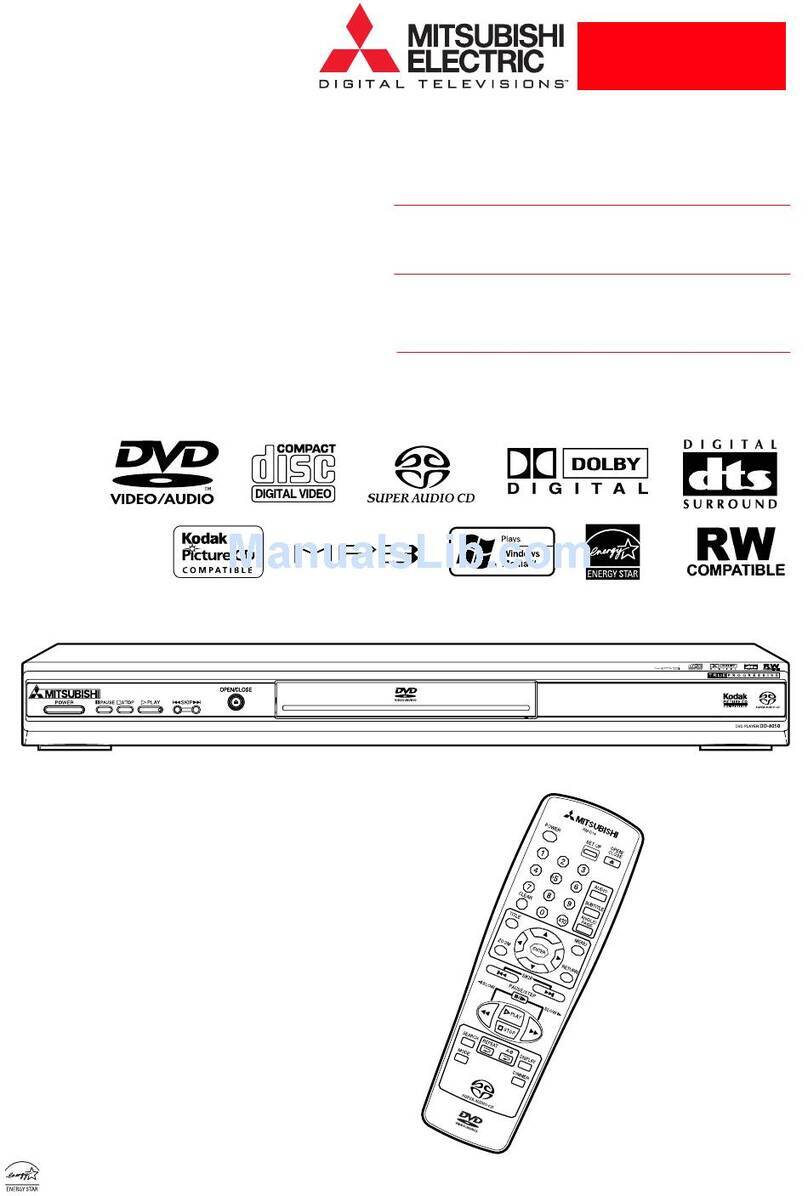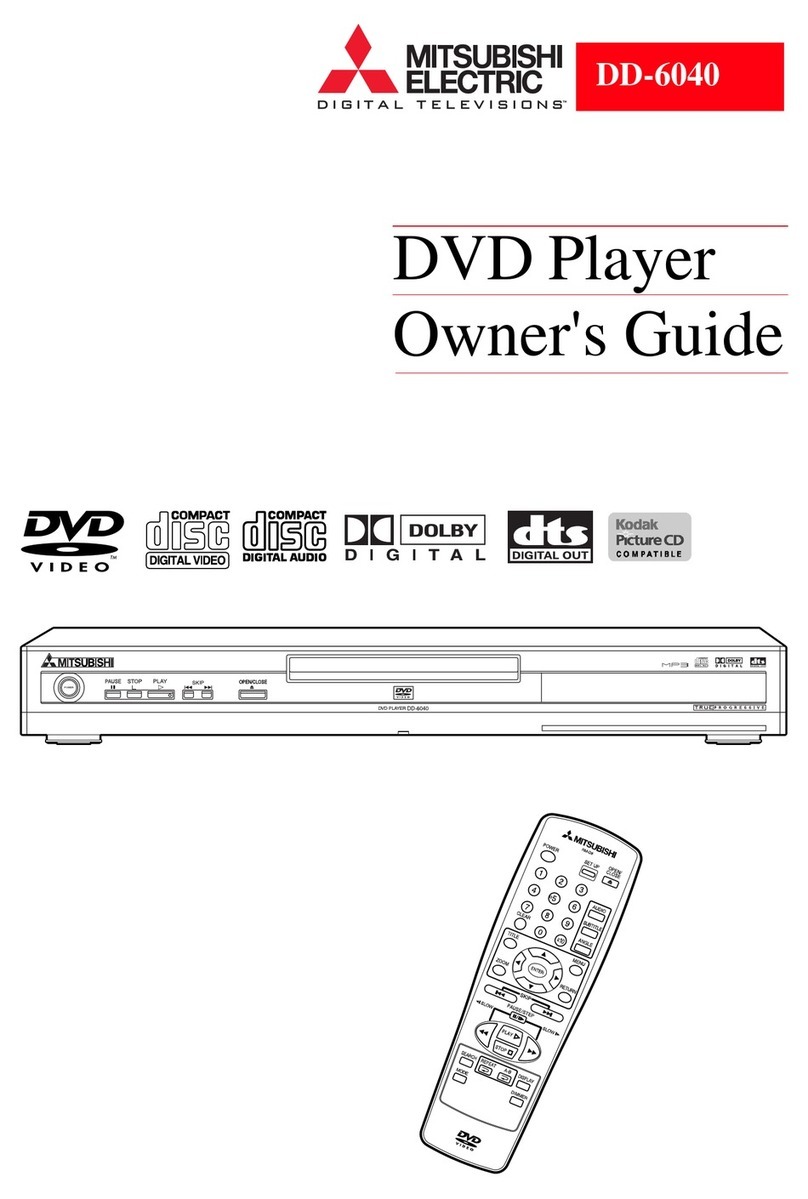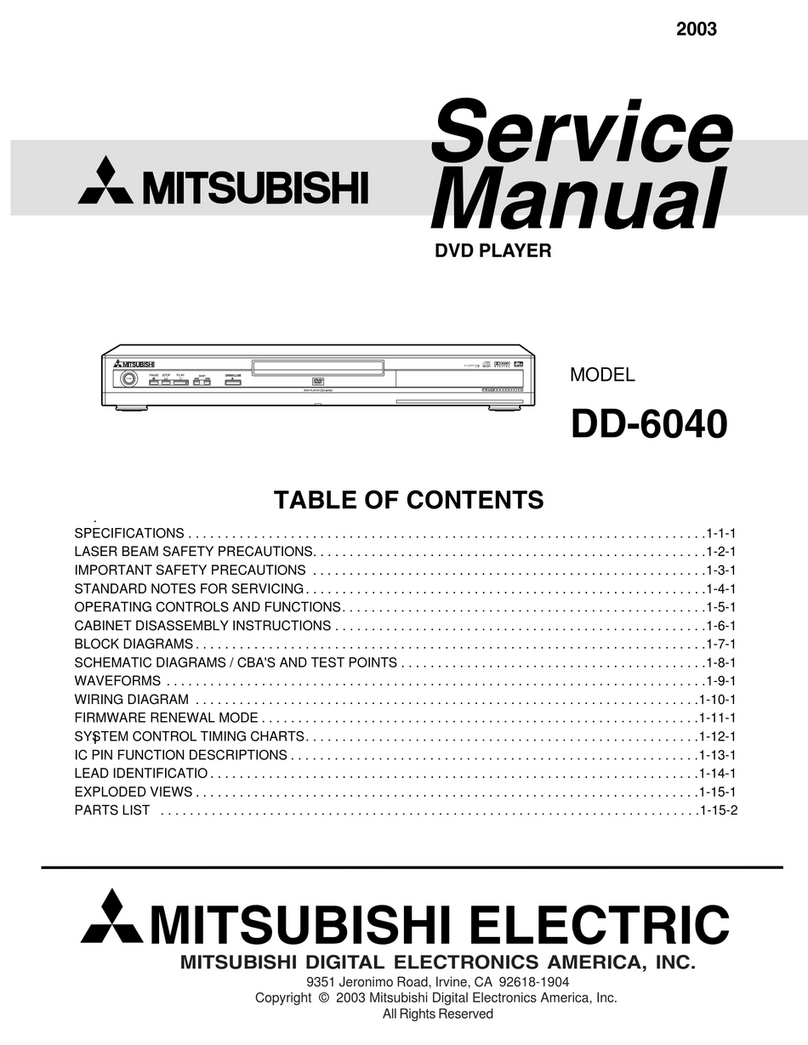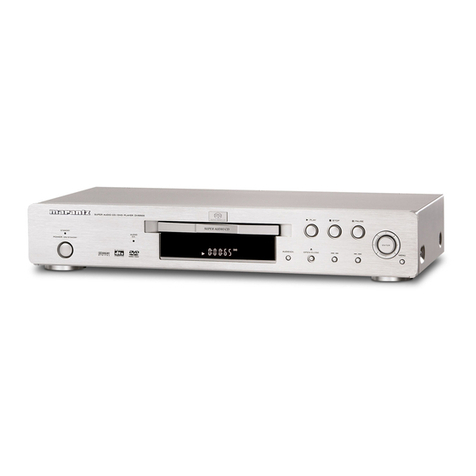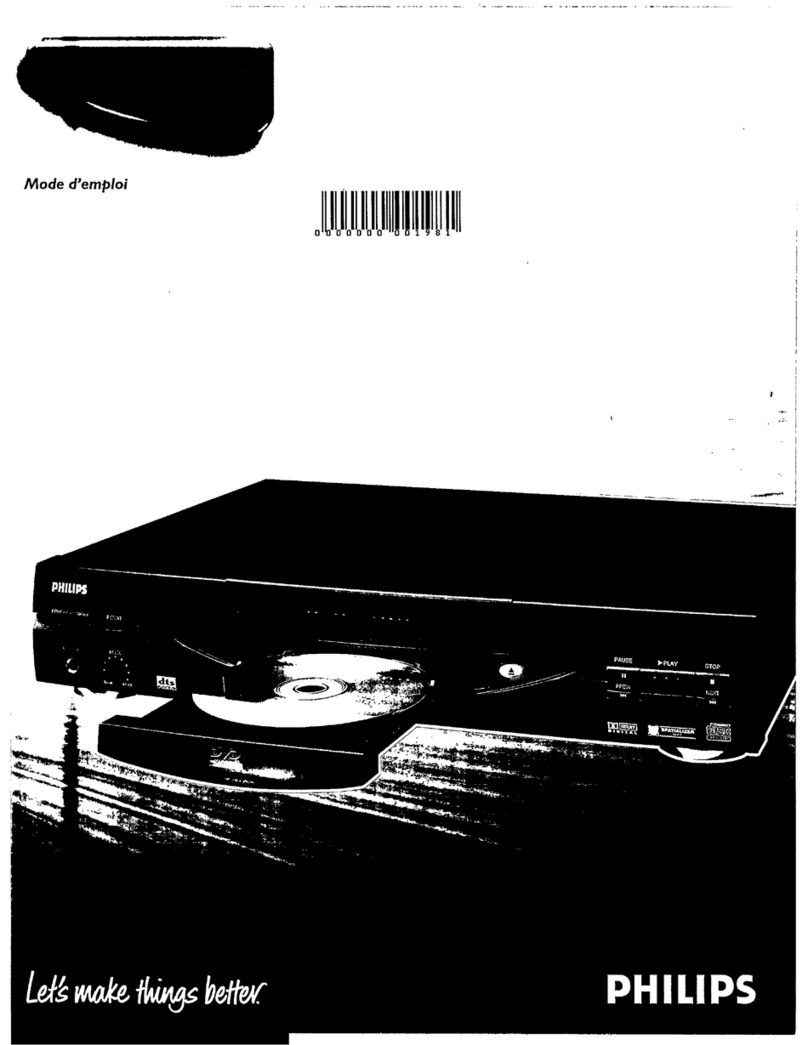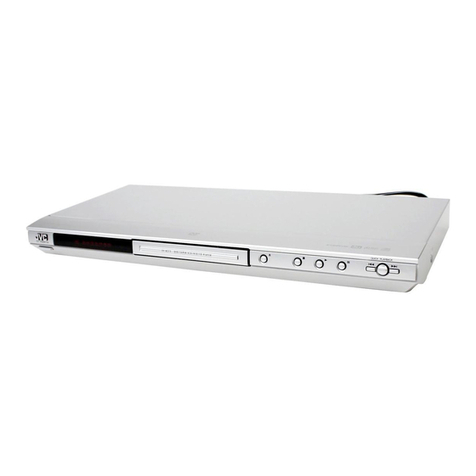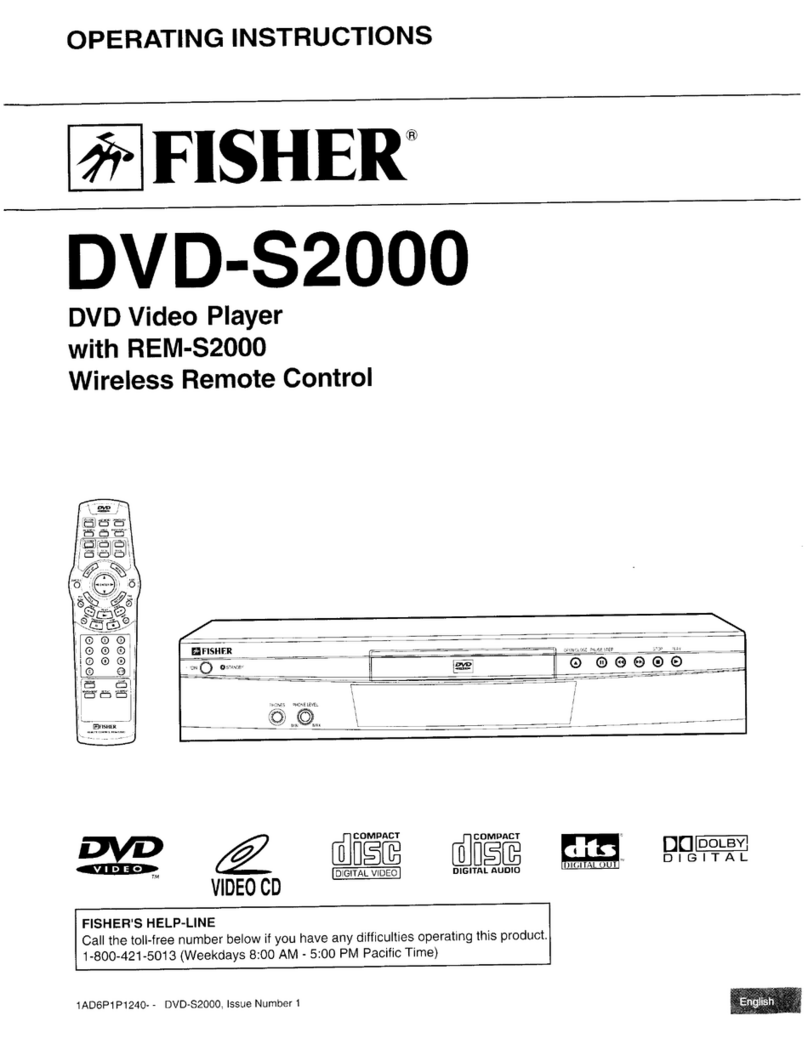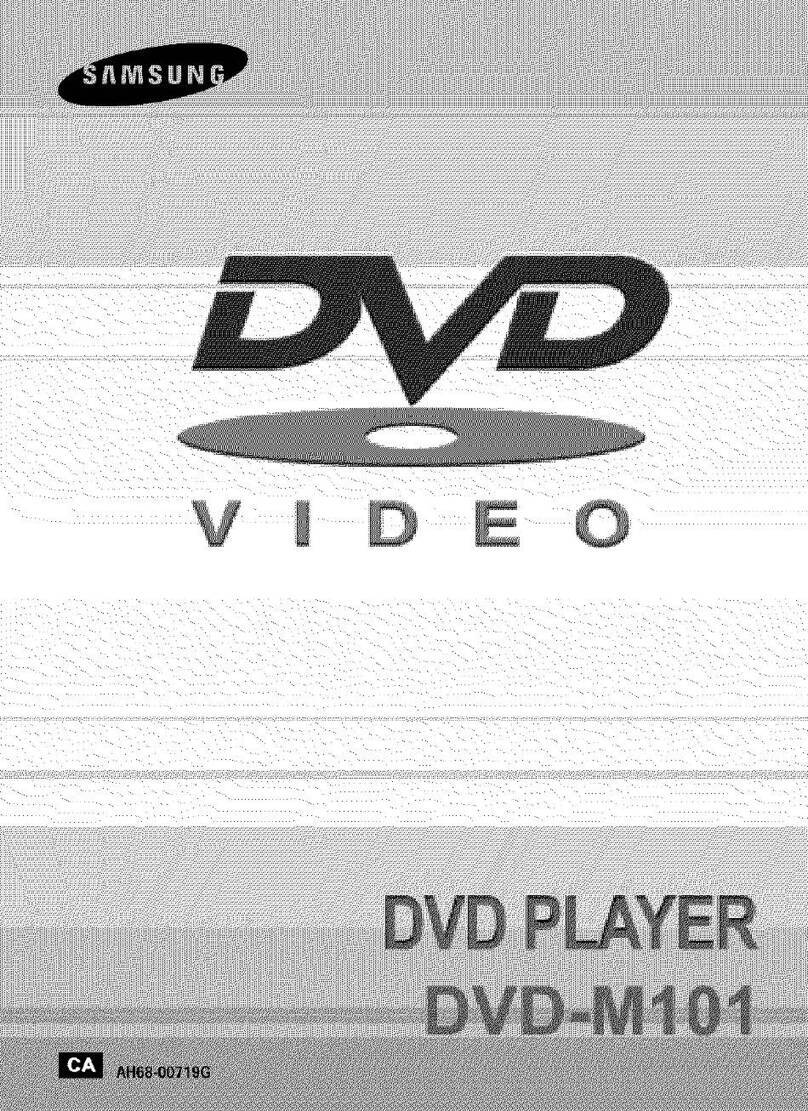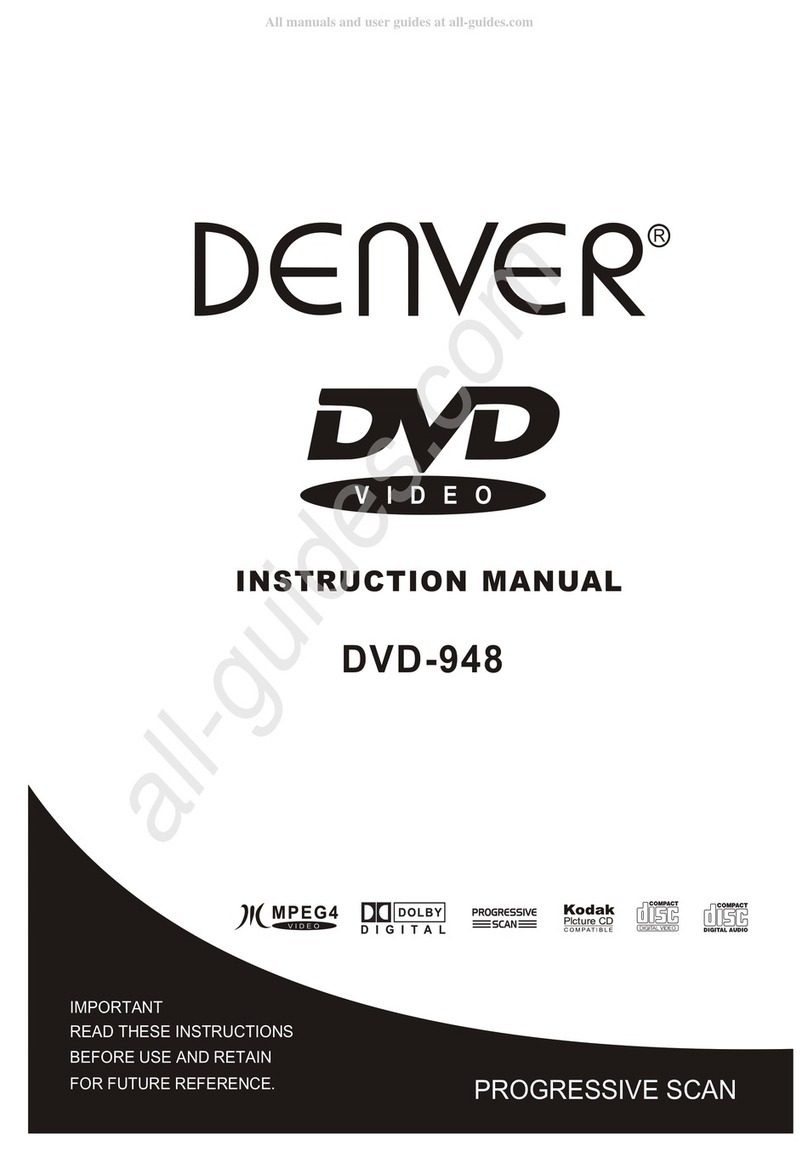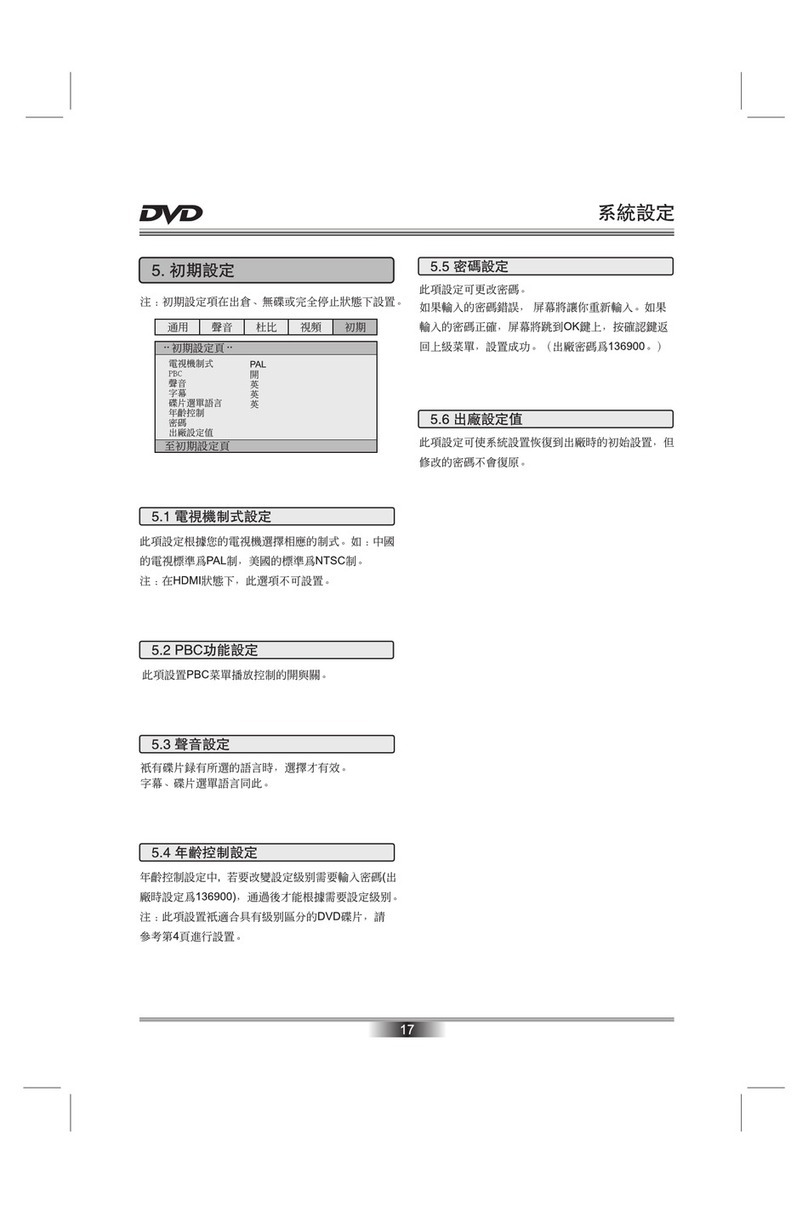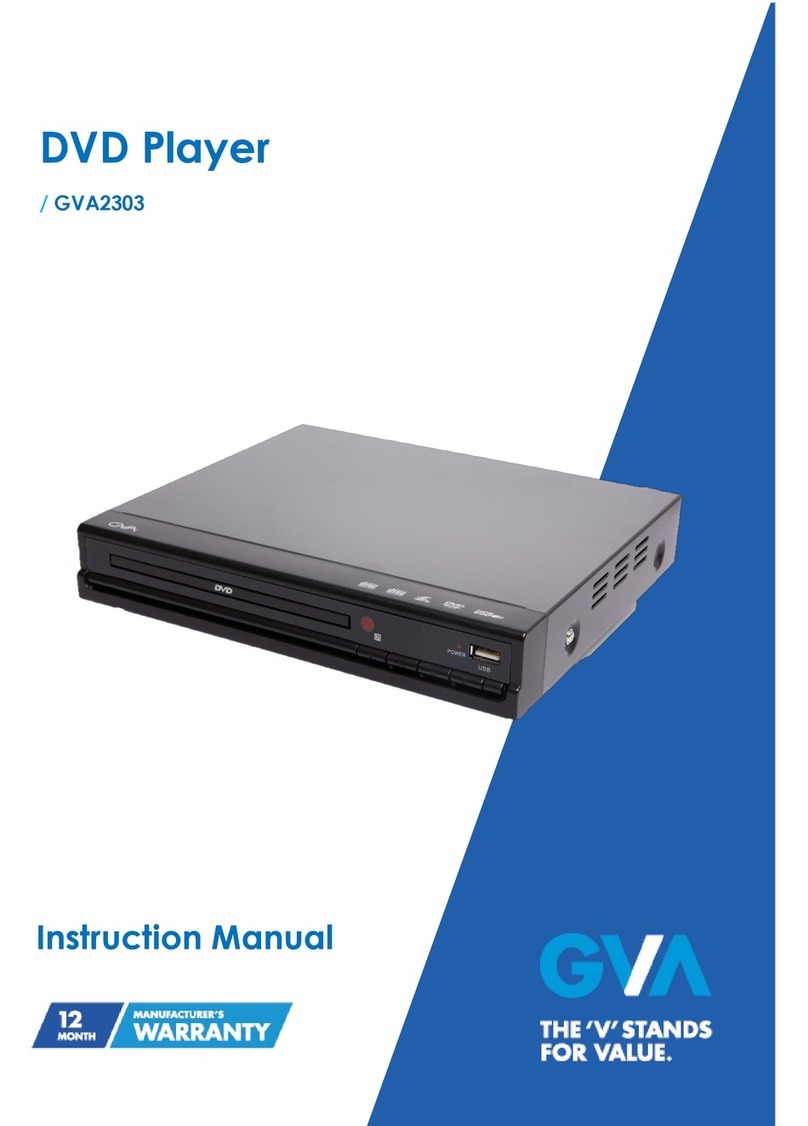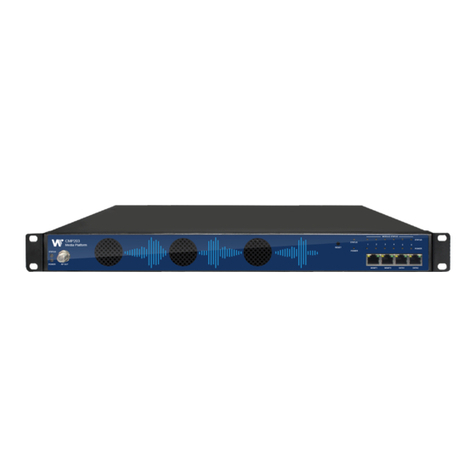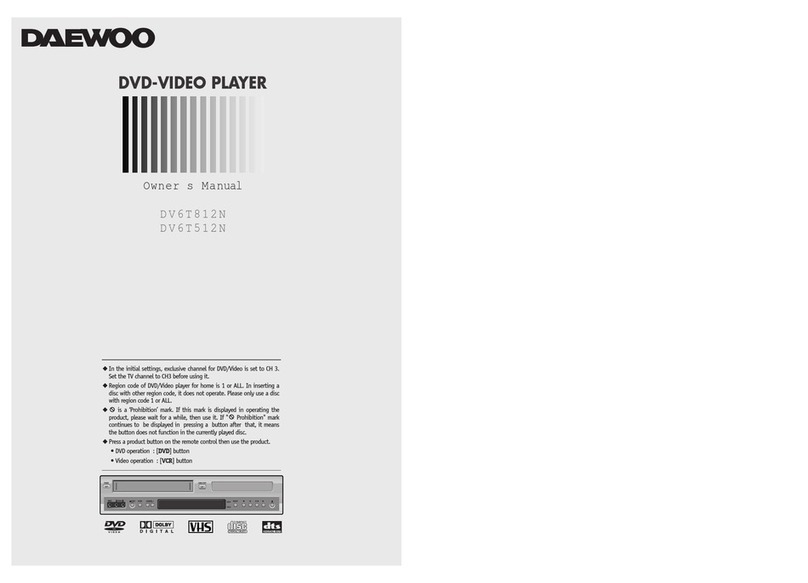Mitsubishi DD-4021 User manual

DVD PLAYER
2001
MODEL
DD-4021
Manual
Service
MITSUBISHI ELECTRIC
TABLE OF CONTENTS
SPECIFICATIONS .......................................................................................................................................... 1-1-1
LASER BEAM SAFETY PRECAUTIONS........................................................................................................ 1-2-1
IMPORTANT SAFETY PRECAUTIONS .......................................................................................................... 1-3-1
STANDARD NOTES FOR SERVICING .......................................................................................................... 1-4-1
CABINET DISASSEMBLY INSTRUCTIONS ................................................................................................... 1-5-1
BLOCK DIAGRAMS ........................................................................................................................................ 1-6-1
SCHEMATIC DIAGRAMS / CBA’S AND TEST POINTS ................................................................................. 1-7-1
WAVEFORMS.................................................................................................................................................. 1-8-1
WIRING DIAGRAM.......................................................................................................................................... 1-9-1
SYSTEM CONTROL TIMING CHARTS ........................................................................................................ 1-10-1
IC PIN FUNCTION DESCRIPTIONS..............................................................................................................1-11-1
LEAD IDENTIFICATIONS.............................................................................................................................. 1-12-1
EXPLODED VIEWS....................................................................................................................................... 1-13-1
MECHANICAL PARTS LIST .......................................................................................................................... 1-14-1
ELECTRICAL PARTS LIST ........................................................................................................................... 1-15-1
MITSUBISHI DIGITAL ELECTRONICS AMERICA, INC.
9351 Jeronimo Road, Irvine, CA 92618-1904
Copyright © 2001Mitsubishi Digital Electronics America, Inc.
All Rights Reserved

HOW TO INITIALIZE THE SETUP MENU
After turning the power ON, without a disc in the tray, press the "1," "2," "3," "4," "DISPLAY" and "ENTER" buttons
on the remote control unit in this order. Then, after turning the power OFF temporarily, turn the power ON again
to intialize the Setup Menu.
HOW TO CLEAR THE PASSWORD PROTECTION
(In casethe ParentalLock password is forgotten)
Torelease parental lock, initialize the setup menu using the procedure above.
HOW TOSET OR CLEAR THE TRAYLOCK
Toset the tray lock mode to on, follow the procedures below:
1. With loading a disc, set the DVD player to the stop mode.
2. Press the "SETUP" button to display the SETUP menu.
3. Press the "TITLE" button.
4. Press the "3" button.
5. Press the "AUDIO" button.
6. Press the "0" button.
7. Press the SETUP" button. Tray Lock mode is set to ON and "Tray Lock On" is displayed on the top right of
the screen.
While the Tray Lockmode ison, the tray cannot be opened or closed. Other operations are available.
Torelease the Tray Lockmode, perform the above procedures again. Tray Lock mode isset to OFF and "Tray
Lock Off" is displayed on the top right of the screen.
HOW TO MANUAL EJECT
1. Remove the Top Case.
2. Insert the eject-bar (length = approximately 3 mm,
diameter = approximately 8 mm) into the manual eject
hole on the PCB Holder. Then, press it until the tray
is ejected.
3. Pull out the tray.
Manufatured under license from Dolby Laboratories. "Dolby" and the double-D symbol are trademarks of Dolby
Laboratories. Confidential Unpublished Works.
(©1992-1997 Dolby Laboratories, Inc. All rights reserved.)
"DTS" and "DTS Digital Out" are trademarks of Digital Theater Systems Inc.
Eject-Bar (Length = approximately 80 mm, Diameter = approximately 3 mm)
Manual
Eject Hole
Tray
Top Case
PCB Holder

SPECIFICATIONS
ITEM CONDITIONS UNIT NOMINAL LIMIT
1 Video Output 75 ohm load Vpp 1.0
2 Optical Digital Out dBm -18
3 Audio(PCM)
3-1. Output Level 1kHz 0dB Vrms 2.0
3-2. S/N dB 110
3-3. Freq. Response
DVD fs=48kHz 20~22kHz dB ±2
CD fs=44.1kHz 20~20 kHz dB ±2
3-4. THD+N 1 kHz 0dB % 0.005
NOTES:
1. All Items are measured without pre-emphasis unless otherwise specified.
2. Power supply : AC120 V 60 Hz
3. Load imp. : 100 K ohm
4. Room ambient : +25 °C
1-1-1 E5500SP

LASER BEAM SAFETY PRECAUTIONS
This DVD player uses a pickup that emits a laser beam.
The laser beam is emitted from the location shown in the figure. When checking the laser diode, be sure to keep your
eyes at least 30cm away from the pickup lens when the diode is turned on. Do not look directly at the laser beam.
Caution: Use of controls and adjustments, or doing procedures other than those specified herein, may result in
hazardous radiation exposure.
Do not look directly at the laser beam coming
from the pickup or allow it to strike against
your skin.
LASER RADIATION
WHEN OPEN. DO NOT
STARE INTO BEAM.
CAUTION
Location: Inside Top of DVD mechanism.
1-2-1 DVD_LASER

IMPORTANT SAFETY PRECAUTIONS
Product Safety Notice
Some electrical and mechanical parts have special
safety-related characteristics which are often not evi-
dent from visual inspection, nor can the protection they
give necessarily be obtained by replacing them with
components rated for higher voltage, wattage, etc. Parts
that have special safety characteristics are identified by
a
#
on schematics and in parts lists. Use of a substi-
tute replacement that does not have the same safety
characteristics as the recommended replacement part
might create shock, fire, and/or other hazards. The
Product’s Safety is under review continuously and new
instructions are issued whenever appropriate. Prior to
shipment from the factory, our products are carefully
inspected to confirm with the recognized product safety
and electrical codes of the countries in which they are
to be sold. However, in order to maintain such compli-
ance, it is equally important to implement the following
precautions when a set is being serviced.
Precautions during Servicing
A.Parts identified by the
#
symbol are critical for
safety. Replace only with part number specified.
B.In addition to safety, other parts and assemblies are
specified for conformance with regulations applying
to spurious radiation. These must also be replaced
only with specified replacements.
Examples: RF converters, RF cables, noise block-
ing capacitors, and noise blocking filters, etc.
C.Use specified internal wiring. Note especially:
1) Wires covered with PVC tubing
2) Double insulated wires
3) High voltage leads
D.Use specified insulating materials for hazardous live
parts. Note especially:
1) Insulation tape
2) PVC tubing
3) Spacers
4) Insulators for transistors
E.When replacing AC primary side components
(transformers, power cord, etc.), wrap ends of wires
securely about the terminals before soldering.
F. Observe that the wires do not contact heat produc-
ing parts (heatsinks, oxide metal film resistors, fus-
ible resistors, etc.).
G.Check that replaced wires do not contact sharp
edges or pointed parts.
H.When a power cord has been replaced, check that
5 - 6 kg of force in any direction will not loosen it.
I.Also check areas surrounding repaired locations.
J.Use care that foreign objects (screws, solder drop-
lets, etc.) do not remain inside the set.
K.Crimp type wire connector
The power transformer uses crimp type connectors
which connect the power cord and the primary side
of the transformer. When replacing the transformer,
follow these steps carefully and precisely to prevent
shock hazards.
Replacement procedure
1)Remove the old connector by cutting the wires at a
point close to the connector.
Important: Do not re-use a connector. (Discard it.)
2)Strip about 15 mm of the insulation from the ends of
the wires. If the wires are stranded, twist the strands
to avoid frayed conductors.
3)Align the lengths of the wires to be connected. Insert
the wires fully into the connector.
4)Use a crimping tool to crimp the metal sleeve at its
center. Be sure to crimp fully to the complete closure
of the tool.
L.When connecting or disconnecting the internal con-
nectors, first, disconnect the AC plug from the AC
outlet.
1-3-1 DVD_SFN1

Safety Check after Servicing
Examine the area surrounding the repaired location for
damage or deterioration. Observe that screws, parts,
and wires have been returned to their original positions.
Afterwards, do the following tests and confirm the speci-
fied values to verify compliance with safety standards.
1. Clearance Distance
When replacing primary circuit components, confirm
specified clearance distance (d) and (d’) between sol-
dered terminals, and between terminals and surround-
ing metallic parts. (See Fig. 1)
Table 1 : Ratings for selected area
AC Line Voltage Clearance Distance (d) (d’)
120 V ≥3.2 mm (0.126 inches)
Note: This table is unofficial and for reference only.
Be sure to confirm the precise values.
2. Leakage Current Test
Confirm the specified (or lower) leakage current be-
tween B (earth ground, power cord plug prongs) and
externally exposed accessible parts (RF terminals, an-
tenna terminals, video and audio input and output ter-
minals, microphone jacks, earphone jacks, etc.) is lower
than or equal to the specified value in the table below.
Measuring Method (Power ON) :
Insert load Z between B (earth ground, power cord plug
prongs) and exposed accessible parts. Use an AC
voltmeter to measure across the terminals of load Z.
See Fig. 2 and the following table.
Table 2 : Leakage current ratings for selected areas
AC Line Voltage Load Z Leakage Current (i) Earth Ground (B) to:
120 V 0.15µF CAP. & 1.5kΩRES.
Connected in parallel i ≤0.5mA Peak Exposed accessible parts
Note: This table is unofficial and for reference only. Be sure to confirm the precise values.
Chassis or Secondary Conductor
dd'
Primary Circuit Terminals
Fig. 1
AC Voltmeter
(High Impedance)
Exposed Accessible Part
BEarth Ground
Power Cord Plug Prongs
Z
1.5kΩ0.15µF
Fig. 2
1-3-2 DVD_SFN1

STANDARD NOTES FOR SERVICING
Circuit Board Indications
a.The output pin of the 3 pin Regulator ICs is indicated
as shown.
b.For other ICs, pin 1 and every fifth pin are indicated
as shown.
c.The 1st pin of every male connector is indicated as
shown.
Instructions for Connectors
1.When you connect or disconnect the FFC (Flexible
Foil Connector) cable, be sure to first disconnect the
AC cord.
2.FFC (Flexible Foil Connector) cable should be in-
serted parallel into the connector, not at an angle.
How to Remove / Install Flat Pack-IC
1. Removal
With Hot-Air Flat Pack-IC Desoldering Machine:
(1)Prepare the hot-air flat pack-IC desoldering ma-
chine, then apply hot air to the Flat Pack-IC (about
5 to 6 seconds). (Fig. S-1-1)
(2)Remove the flat pack-IC with tweezers while apply-
ing the hot air.
(3)Bottom of the flat pack-IC is fixed with glue to the
CBA; when removing entire flat pack-IC, first apply
soldering iron to center of the flat pack-IC and heat
up. Then remove (glue will be melted). (Fig. S-1-6)
(4)Release the flat pack-IC from the CBA using tweez-
ers. (Fig. S-1-6)
Caution:
1.Do not supply hot air to the chip parts around the flat
pack-IC for over 6 seconds because damage to the
chip parts may occur. Put masking tape around the
flat pack-IC to protect other parts from damage.
(Fig. S-1-2)
2.The flat pack-IC on the CBA is affixed with glue, so
be careful not to break or damage the foil of each
pin or the solder lands under the IC when removing
it.
Hot-air
Flat Pack-IC
Desoldering
Machine
CBA
Masking
Tape
Tweezers
Flat Pack-IC
Fig. S-1-2
Fig. S-1-1
Top View
Out In
Bottom View
Input
5
10
Pin 1
Pin 1
FFC Cable
Connector
CBA
* Be careful to avoid a short circuit.
1-4-1 DVD_NOTE

With Soldering Iron:
(1)Using desoldering braid, remove the solder from all
pins of the flat pack-IC. When you use solder flux
which is applied to all pins of the flat pack-IC, you
can remove it easily. (Fig. S-1-3)
(2)Lift each lead of the flat pack-IC upward one by one,
using a sharp pin or wire to which solder will not
adhere (iron wire). When heating the pins, use a fine
tip soldering iron or a hot air desoldering machine.
(Fig. S-1-4)
(3)Bottom of the flat pack-IC is fixed with glue to the
CBA; when removing entire flat pack-IC, first apply
soldering iron to center of the flat pack-IC and heat
up. Then remove (glue will be melted). (Fig. S-1-6)
(4)Release the flat pack-IC from the CBA using tweez-
ers. (Fig. S-1-6)
With Iron Wire:
(1)Using desoldering braid, remove the solder from all
pins of the flat pack-IC. When you use solder flux
which is applied to all pins of the flat pack-IC, you
can remove it easily. (Fig. S-1-3)
(2)Affix the wire to a workbench or solid mounting point,
as shown in Fig. S-1-5.
(3)While heating the pins using a fine tip soldering iron
or hot air blower, pull up the wire as the solder melts
so as to lift the IC leads from the CBA contact pads
as shown in Fig. S-1-5.
(4)Bottom of the flat pack-IC is fixed with glue to the
CBA; when removing entire flat pack-IC, first apply
soldering iron to center of the flat pack-IC and heat
up. Then remove (glue will be melted). (Fig. S-1-6)
(5)Release the flat pack-IC from the CBA using tweez-
ers. (Fig. S-1-6)
Note:
When using a soldering iron, care must be taken to
ensure that the flat pack-IC is not being held by glue.
When the flat pack-IC is removed from the CBA,
handle it gently because it may be damaged if force
is applied.
Flat Pack-IC Desoldering Braid
Soldering Iron
Fig. S-1-3
Fine Tip
Soldering Iron
Sharp
Pin
To Solid Mounting Point
Hot Air Blower
Iron Wire
Soldering Iron
or
Fig. S-1-4
Fig. S-1-5
CBA
Tweezers
Flat Pack-IC
Fine Tip
Soldering Iron
Fig. S-1-6
1-4-2 DVD_NOTE

2. Installation
(1)Using desoldering braid, remove the solder from the
foil of each pin of the flat pack-IC on the CBA so you
can install a replacement flat pack-IC more easily.
(2)The " ●" mark on the flat pack-IC indicates pin 1.
(See Fig. S-1-7.) Be sure this mark matches the 1
on the PCB when positioning for installation. Then
pre- solder the four corners of the flat pack-IC. (See
Fig. S-1-8.)
(3)Solder all pins of the flat pack-IC. Be sure that none
of the pins have solder bridges.
Instructions for Handling
Semiconductors
Electrostatic breakdown of the semiconductors may
occur due to a potential difference caused by electro-
static charge during unpacking or repair work.
1. Ground for Human Body
Be sure to wear a grounding band (1MΩ) that is properly
grounded to remove any static electricity that may be
charged on the body.
2. Ground for Workbench
Be sure to place a conductive sheet or copper plate with
proper grounding (1MΩ) on the workbench or other
surface, where the semiconductors are to be placed.
Because the static electricity charge on clothing will not
escape through the body grounding band, be careful to
avoid contacting semiconductors with your clothing.
CBA
CBA
Grounding Band
Conductive Sheet or
Copper Plate
1MΩ
1MΩ
Presolder
Soldering Iron
CBA Flat Pack-IC
Example :
Pin 1 of the Flat Pack-IC
is indicated by a " ●" mark.
Fig. S-1-7
Fig. S-1-8
< Incorrect >
< Correct >
1-4-3 DVD_NOTE

CABINET DISASSEMBLY INSTRUCTIONS
1. Disassembly Flowchart
This flowchart indicates the disassembly steps to gain
access to item(s) to be serviced. When reassembling,
follow the steps in reverse order. Bend, route, and dress
the cables as they were originally.
2. Disassembly Method
ID/
LOC.
No. PART
REMOVAL
Fig.
No.
REMOVE/
*UNHOOK/UNLOCK/
RELEASE/UNPLUG/
DESOLDER
Note
[1] Top Case 1 5(S-1) -
[2] Front
Assembly 2*2(L-1), Tray Panel,
*2(L-2), *5(L-3) 1-1
1-2
[3] Function
CBA 3 *3(L-4), *(CN2001) -
[4] PCB
Holder 42(S-2) -
[5] DVD
Mecha 4,5 *(CN001, CN201),
2(S-3)
2-1
2-2
2-3
3
[6] AV CBA 6 4(S-4), 4(S-5),
*2(L-5), *(CN701,
CN501) -
[7] DVD
Mecha
CBA Unit 64(S-6) -
[8] Rear
Panel 73(S-7) -
↓
➀↓
➁↓
➂↓
➃↓
➄
Reference Notes
CAUTION 1: Locking Tabs (L-1) are fragile. Be careful
not to break them.
1-1.Connect the wall plug to an AC outlet and press the
OPEN/CLOSE button to open the Tray.
1-2.First, remove the Tray Panel by releasing two Lock-
ing Tabs (L-1). Second, release two Locking Tabs
(L-2). Then, release five Locking Tabs (L-3) (to do
this, first release three Locking Tabs (A) at the
bottom, and then two Locking Tabs (B) at the side.)
(Fig. 2)
CAUTION 2: Electrostatic breakdown of the laser diode
in the optical system block may occur as a potential
difference caused by electrostatic charge accumulated
on cloth, human body etc, during unpacking or repair
work.
To avoid damage of pickup follow next procedures.
2-1.Slide out the pickup unit as shown in Fig. 5.
2-2.Short the copper pattern (half-moon shape) of FPC
cable with solder before removing the FFC cable
(CN001) from it. If you disconnect the FFC cable
(CN001), the laser diode of pickup will be destroyed.
(Fig. 5)
2-3.Disconnect Connector (CN201). Remove two
Screws (S-3) and lift the DVD Mecha. (Fig. 4)
CAUTION 3: When reassembling, confirm the FFC
cable (CN001) is connected completely. Then remove
the solder from copper pattern (half-moon shape) of
FPC cable. (Fig. 5)
[1] Top Case
[2] Front Assembly
[3] Function CBA
[4] PCB Holder
[5] DVD Mecha
[7] DVD Main CBA Unit[6] AV CBA
[8] Rear Panel
1 : Identification (location) No. of parts in the figures
2 : Name of the part
3 : Figure Number for reference
4 : Identification of parts to be removed, unhooked, un-
locked, released, unplugged, unclamped, or
desoldered.
P=Spring, L=Locking Tab, S=Screw,
CN=Connector
*=Unhook, Unlock, Release, Unplug, or Desolder
e.g. 2(S-2) = two Screws (S-2),
2(L-2) = two Locking Tabs (L-2)
5 :Refer to "Reference Notes."
1-5-1 E5540DC

[3] Function
CBA CN2001
(L-4)
(L-4)
Fig. 3
[4] PCB
Holder
[5] DVD
Mecha
(S-3) (S-3) (S-2)
CN001
CN201
Fig. 4
DVD Mecha
Bottom View
Pickup Unit A
Short the copper pattern
by soldering
View for A
Slide
Fig. 5
[2] Front Assembly
Tray Panel
(B)
(B)
(L-3)
(L-2)
(L-1)
(L-1)
(A)
Fig. 2
(S-1)
(S-1)
[1] Top Cover
(S-1)
Fig. 1
1-5-2 E5540DC

[8] Rear Panel (S-7)
Fig. 7
[6] AV CBA
[7] DVD Main CBA Unit
(S-6)
(S-6)
(S-6)
(L-5)
(S-4)
(S-4)
(S-5)
(S-5)
CN701
CN501
(S-5)
Fig. 6
1-5-3 E5540DC

System Control Block Diagram
E5542BLS
1-6-1 1-6-2
60
61
25
26
30
50
IC400
(FRONT END PROCESSOR) IC601
(DVD HOST PROCESSOR)
XIN
XOUT
81
80 16MHz
X401
CLOCK
X601
27MHz
120
SDA
SCL
RDY-HIF
/FERS
TREV
TFW
TIN
TOUT
SDA
SCL
RDY-HIF
/FERS
TIN
TOUT
5 CSL
CSL 6
5
99 MUTE
100
PS
1 RS
51 HINT
95 HCS
37 JITTER
14 MRDY
JITTER
MRDY
94 MCS
MCS
7 MALE
MALE
FG 52 FG
FROM/TO
DVD SIGNAL
PROCESS
BLOCK
DIAGRAM
FROM/TO
RF SIGNAL
PROCESS
/SERVO
BLOCK
DIAGRAM
HD0
HD7
HD0-HD7 83
90
~
~
SCL
SDA
IC603
(MEMORY)
3VFD-STB
1VFD-DIN
2
VFD-DOUT
125
REMOTE
204
VFD-CLK
CN501 CN1001
CN2001
JP1003JP1004
CN2003
9
7
6
819
14
15
16
17
18
REMOTE
SENSOR
RM2001
1G
11G
~
42
32
~
a/KEY-1
b/KEY-2
c/KEY-3
d/KEY-4
e
f
g
h
i
K1
K2
FP-STB
FP-DIN
FP-DOUT
FP-CLK
GRID FIP
SEGMENT
FL2002
IC2003
KEY MATRIX
MAIN CBA UNIT FUNCTION CBA
AV CBA
SWITCH CBAFG CBA MECHA CBA
INNER
CBA
(FRONT PANEL CONTROL)
BLOCK DIAGRAMS
CN3004 CN3003
10 HWR
TREV
TIN
TOUT
TFW
MUTE
PS
RS
HINT
HCS
HWR
8HRD
92 HA0
93 HA1
HRD
HWR
HRD
HA0
HA1
3 SCLKH
SCLKH
4 SDATA
SDATA
20
21
22
10
11
j23
FG
SENSOR FG-IN 6
6
CN201
FP-STB 19
19
KEY-4 1
1
KEY-3 2
2
KEY-2 3
3
KEY-1 4
4
K2 5
5
K1 6
6
FP-DIN 20
20
FP-DOUT 21
21
FP-CLK 22
22
REMOTE 24
24
1 3
2 4
IC002
(OP AMP)
IC608
(INVERTER)
200
201
187
188
196
195
208
186
KEY-2 1
1
K2 2
2
POWER SW
FG-IN 10

TRAY-OUT
TRAY-IN
TREV
TFW FROM/TO
SYSTEM
CONTROL
BLOCK
FROM
DVD SIGNAL
PROCESS
BLOCK
PS
M M
RF Signal Process/Servo Block Diagram
E5542BLRF1-6-3 1-6-4
A 3
D 4
C 1
B 2
F 7
E 8
LD 11
MON 12
GND 9
GND 10
FS(+) 17
FS(-) 16
TS(+) 15
TS(-) 18
CN001
CN001
CN001
LD(+) 1
LD(-) 2
SPL(-) 6
SPL(+) 7
SL(+) 9
SL(-) 8
SPL(-) 11
SPL(+) 22
SL(-) 33
SL(+) 44
CN201
IC200 (SERVO DRIVE)
IC001
(RF SIGNAL PROCESS)
IC100 (SERVO DSP)
FSTS
PICK-UP UNIT
MECHA CBA
INNER
CBA
DETECTOR
28
30
29
18
17
15
16
5 6
40
39
27 INPUT
MATRIX
RF
AMP
DATA SLICER
ASYMMETRY
CONTROL
AGC AMP
PROGRAMMABLE EQ
TRACKING
ERROR DET
MIRROR DET
DEFECT DET
FOCUS
ERROR DET
FOCUS ON
GATE SIGNAL CONTROL
REGISTERS
MCU
I/F
PB-ALPC
MUTE
MUTE
PWM2
PWM1
Q001
76
77
52
51
74
69
73
53
66
67
68
60
58
12 6
11
14
13
10
9
18
17
16
15
AMP
FOCUS
DRIVE
TRACKING
DRIVE
LOADING
MOTOR DRIVE
SPINDLE
MOTOR DRIVE
POWER
SAVE
SLIDE
MOTOR DRIVE
LOADING
MOTOR
SPINDLE
MOTOR
SLIDE
MOTOR
M
5
21
2
1
23
26
25
27
22
24
4
1
19
5
79
81
80
78
77
76
68
3 52
95
27
26
34
7
70
TP202
TP201
TP104 8 10
7 5
14 12
IC102
(OP AMP)
1 3
8
23
22 10
MAIN CBA UNIT
HA1
HAO
HRD
HWR
HCS
HINT
RS
FROM/TO
SYSTEM CONTROL
BLOCK DIAGRAM
FROM
SYSTEM CONTROL
BLOCK DIAGRAM
TO DVD SIGNAL
PROCESS
BLOCK DIAGRAM
SCLKH
DEFECT
TC
SRV33M
NRZP
NRZN
SDATA
CSL
41
TRAY-IN 3
GND 5
TRAY-OUT 4
CN201
TRAY-IN
TRAY-OUT
FS
TS
TP001 TP002
MONREF MONREP
WF1 WF2
IC002
(OP AMP)
FE
TP103
TE
TP102
CLKINFSGATE
PDM2
PDM0
PDM3
ADC4
PDM1
TC
ASO
TP101
21 14 12
RF(VIDEO/AUDIO) SIGNAL FOCUS SERVO SIGNAL TRACKING SERVO SIGNAL SLIDE SERVO SIGNAL DISK SERVO SIGNAL
90
86
~
84
82
~
HD0-HD7
MIRROR
TZC
DEFECT
ADC1
ADC0
ADC2
RS
HINT
HCS
HWR
HRD
HA0
HA1
HD0
HA7
~
+
-
+
-
VREF165
TP203
PWM
TP205
SL
CN3004 CN3003
25
26

DVD Signal Process Block Diagram
E5542BLD1-6-5 1-6-6
IC300 (DVD SIGNAL PROCESS)
IC301 (4M D-RAM)
HD0
HD0-HD7
HD1
HD2
HD3
HD4
HD5
HD6
HD7
FROM RF SIGNAL
PROCESS/SERVO
BLOCK DIAGRAM
FROM/TO
SYSTEM CONTROL
BLOCK DIAGRAM
118
117
NRZN
NRZP
TC
DEFECT
94
DATA
SLICER
PLL
VCO
CPU
INTERFACE
VIDEO/AUDIO
INTERFACE
DVD
DEMODULATOR
MEMORY
MANAGER
24
27
30
34
37
40
43
46
95
86
190
189
174
173
175
~
~
~
HD0
~
HD7
HD0-HD8
RA0-RA8
RD0-RD15
TO RF SIGNAL
PROCESS/SERVO
BLOCK DIAGRAM
TO VIDEO BLOCK
SRV33M
X301 (33MHz)
PWM1
PWM2 CLV/CAV
MASTER
CLOCK
99
57
100
101
156
FG
BCA
WE
OE
WE
RAS
UCAS
LCAS
RAS
UCAS
LCAS
OE
RA0 RA0
RA8RA8
RD0 RD0
RD15
RD15 2
1
13
29
28
14
27
~
69
77
~
16
26
~
2
10
~
207
191
~
31
39
~
187
177
~
MCS
124
JITTER
83 MRDY
81 HRD
79 HWR
JITTER
MRDY
HRD
HWR
80 MALE
MALE
155
MCS
DATA(VIDEO/AUDIO) SIGNAL DATA(VIDEO) SIGNAL DATA(AUDIO) SIGNALRF(VIDEO/AUDIO) SIGNAL
WF5
WF4
MAIN CBA UNIT

Video Block Diagram
E5542BLV1-6-7 1-6-8
6dB AMP
6dB AMP
6dB AMP
Q1441, Q1442
AMP
75Ω
BUFFER
75Ω
BUFFER
75Ω
BUFFER
Q1445
JK1401
S-VIDEO
OUT
JK1201
COMPOSITE
VIDEO OUT
VIDEO-Y
OUT
VIDEO-U
OUT
VIDEO-V
OUT
JK1202
3 4
21
Q1423
Q1403
Q1421, Q1422
Q1401, Q1402
CN701 CN1601
5 5VIDEO-Y
3 3VIDEO-U
1 1VIDEO-V
7 7
VIDEO-CVBS
9 9VIDEO-C
3 4
21
AV CBA
DATA(VIDEO) SIGNAL VIDEO SIGNAL AUDIO SIGNALDATA(AUDIO) SIGNAL
IC601 (DVD HOST PROCESSOR)
IC606
IC602
(16M SD-RAM)
PARA0
PARA7
A0
A18
DQ0
AD0
AD13
DQ15
DQ0
DQ15
CS3
DQM(0)
AD0
AD13
~
DQ0
DQ15
~
~
~
~
A0
A18
~
~
~
DQ0-DQ15
A0-A18
PARA0-PARA7
79 80 78
34
25
27
51
52
53
54
55
56
57
33
32
7677
17 18 39 16
8
1
~
25
16
~
6
13
~
29
45
~
DQ0
DQ15
DQML
DQMU
WE
~
15
(64Mbit SDRAM)
20 26~2 13~29 35~42 53~
173
181
~
161
170
~
141
158
~
11
26
28
128
132
117
DATA(VIDEO/AUDIO) SIGNAL DATA(VIDEO) SIGNAL
RAS
CAS
LDQM
UDQM
WE
RAS
CAS
58 63~69 66~84
102
~70 73~
INTERNAL
PERIPHERALS
PORTS
PROGRAMMABLE
CPU INTERFACE
CENTRAL
COMMAND
PORT
FRONT-END
& LINK
INTERFACE
ST20 ARBITER &
MEMORY CONTROLLER
SDRAM ARBITER
SHARED SDRAM INTERFACE
MPEG2 PER
PARSER & MPEG1
SYSTEM PARSER
VIDEO
CD FIFO
VIDEO
DECODER
AUDIO
DECODER
CACHE
SUBSYSTEM
CPU
VIDEO
FILTERING
OSD, SP
DECODER
& MIXING
AUDIO
CD FIFO
SUB
PICTURE
CD FIFO
DENC &
DAC
SPDIF
PCM-LRCLK
PCM-MCLK
PCM-DATA2
PCM-DATA1
PCM-DATA0
PCM-SCLK
FROM
DVD SIGNAL
PROCESS
BLOCK TO AUDIO
BLOCK
WF7WF6
WF5
75Ω
BUFFER
Q1443
75Ω
BUFFER
Q1463
75Ω
BUFFER
Q1483
6dB AMP
Q1461, Q1462
6dB AMP
Q1481, Q1482
CE
OE
WE
OE
MAIN CBA UNIT

Audio Block Diagram
E5542BLA
1-6-9 1-6-10
IC801 (AUDIO DAC)
7
8
12
11
JK1201
JK1202
DIGITAL
AUDIO OUT
AMP
Q1351
IC1201
Q1203
Q1201
Q1202
+3.3V
(AMP)
CN701 CN1601
REF
CN701 CN1601
15 15AUDIO-L
17 17
AUDIO-R
14 14A-L MUTE
16 16A-R MUTE
18 18A-MUTE
AUDIO-L
OUT
1
2
3
13
14
15
16
FROM
SYSTEM
CONTROL
BLOCK
TO
VIDEO
BLOCK
SERIAL
PORT
SERIAL
CONTROL
4X/8X
OVERSAMPLING
DIGITAL FILTER
/FUNCTION
CONTROLLER
ENPHANCED
MULTI-LEVEL
DELTA-SIGMA
MODULATOR
DAC LPF+AMP L-CH
R-CH
LPF+AMP
DAC
ZERP DETECT
SYSTEM CLOCK
31
2
67
5AUDIO-R
OUT
PCM-SCLK
SPDIF
PCM-DATA0
PCM-LRCK
ADAC-MD
ADAC-MC
ADAC-ML
PCM-MCLK
FROM
VIDEO
BLOCK
AV CBA
MAIN CBA UNIT
VIDEO SIGNAL AUDIO SIGNALDATA(AUDIO) SIGNAL
12 12
SPDIF
A-MUTE
+3.3V
Q1204
WF11WF10
WF9
WF12

NOTE :
The voltage for parts in hot circuit is measured using
hot GND as a common terminal.
Power Supply Block Diagram
CAUTION !
Fixed voltage power supply circuit is used in this unit.
If Main Fuse (F1001) is blown, check to see that all components in the
power supply circuit are not defective before you connect the AC plug to
the AC power supply. Otherwise it may cause some components in the
power supply circuit to fail.
A V
E5542BLP1-6-11 1-6-12
AC1001
AC CORD F1001
1A 250V
CHOKE
COIL
L1001
D1001, D1002
D1004, D1005
Q1003
Q1008
Q1001
2
4
7
3
4
IC1001
ERROR
VOLTAGE DET
T1001
11
12
13
15
14
16
17
18
EV+3.3V
EV+9V
P-ON+3.3V(D)
P-ON+3.3V(A)
F1
P-ON+5V(D)
P-ON+5V(A)
EV+2.5V
F2
P-ON+12V
P-ON+5V
P-ON+3.3V
EV+5V
-FL
MAIN CBA UNIT
Q1009
(SHUNT REGULATOR)
SWITCHING
D1008
RECTIFIER
D1030
RECTIFIER
D1003
RECTIFIER
IC1004
IC1003
IC302
+3.3V
REG.
Q1002
+12V
REG.
+3.3V
REG.
Q1004
CN1001 CN501
Q1005
Q1006
D1009
RECTIFIER
D1013
RECTIFIER
D1016
RECTIFIER
SWITCHING
CONTROL
LATCH
REG
REG
1
2
6
BRIDGE
RECTIFIER
Q1007
Q1010
1
2
3
4
12
13
14
15
13
16
12
17
4
18
3
2
1
EV+9V
P-ON+5V
P-ON+5V
EV+9V
EV+3.3V
EV+3.3V
P-ON+3.3V
P-ON+3.3V
PWRCON
5 4
EV+2.5V
EV+2.5V
14
15
16
17
18
COLD
HOT
AV CBA
PWRCON
FROM
SYSTEM
CONTROL
BLOCK
DIAGRAM
-REPLACE FUSE AS MARKED.
"Ce symbole reprèsente un fusible à fusion rapide."
CAUTION
FOR CONTINUED PROTECTION AGAINST FIRE HAZARD,
REPLACE ONLY WITH THE SAME TYPE FUSE.
ATTENTION : POUR UNE PROTECTION CONTINUE LES RISQES
D'INCELE N'UTILISER QUE DES FUSIBLE DE MEMO TYPE.
RISK OF FIRE
"This symbol means fast operating fuse."
A V
F
A V
F

SCHEMATIC DIAGRAMS / CBA’S AND TEST POINTS
Standard Notes
Warning
Many electrical and mechanical parts in this chassis
have special characteristics. These characteristics
often pass unnoticed and the protection afforded by
them cannot necessarily be obtained by using replace-
ment components rated for higher voltage, wattage, etc.
Replacement parts that have these special safety char-
acteristics are identified in this manual and its supple-
ments; electrical components having such features are
identified by the mark "
#
" in the schematic diagram
and the parts list. Before replacing any of these compo-
nents, read the parts list in this manual carefully. The
use of substitute replacement parts that do not have the
same safety characteristics as specified in the parts list
may create shock, fire, or other hazards.
Capacitor Temperature Markings
Mark Capacity
change rate Standard
temperature Temperature
range
(B) ±10% 20°C -25~+85°C
(F) +30 -80% 20°C -25~+85°C
(SR) ±15% 20°C -25~+85°C
(Z) +30 -80% 20°C -10~+70°C
Capacitors and transistors are represented by the fol-
lowing symbols.
Note:
1. Do not use the part number shown on these draw-
ings for ordering. The correct part number is shown
in the parts list, and may be slightly different or
amended since these drawings were prepared.
2. All resistance values are indicated in ohms (K=103,
M=106).
3. Resistor wattages are 1/4W or 1/6W unless other-
wise specified.
4.All capacitance values are indicated in µF
(P=10−6µF).
5.All voltages are DC voltages unless otherwise speci-
fied.
(Top View) (Bottom View)
(Bottom View)
Electrolytic Capacitor
+
Transistor or Digital Transistor
NPN Transistor PNP Transistor
NPN Digital Transistor PNP Digital Transistor
(Top View)
(Top View)
E C B
E C B
Digital Transistor
CBA Symbols Schematic Diagram Symbols
E C B
(Top View)
(Top View)
E C B
E C B
1-7-1 DVD_SC01

LIST OF CAUTION, NOTES, AND SYMBOLS USED IN THE SCHEMATIC DIAGRAMS ON THE FOLLOWING
PAGES:
1. CAUTION:
FOR CONTINUED PROTECTION AGAINST FIRE HAZARD, REPLACE ONLY WITH THE SAME
TYPE FUSE.
ATTENTION: POUR UNE PROTECTION CONTINUE LES RISQES D’INCELE N’UTILISER QUE
DES FUSIBLE DE MEMO TYPE.
RISK OF FIRE-REPLACE FUSE AS MARKED.
2. CAUTION:
Fixed Voltage (or Auto voltage selectable) power supply circuit is used in this unit.
If Main Fuse (F001) is blown, first check to see that all components in the power supply circuit are not defective
before you connect the AC plug to the AC power supply. Otherwise it may cause some components in the power
supply circuit to fail.
3. Note:
(1)Do not use the part number shown on the drawings for ordering. The correct part number is shown in the parts
list, and may be slightly different or amended since the drawings were prepared.
(2)To maintain original function and reliability of repaired units, use only original replacement parts which are listed
with their part numbers in the parts list section of the service manual.
4. Wire Connectors
(1)Prefix symbol "CN" means "connector" (can disconnect and reconnect).
(2)Prefix symbol "CL" means "wire-solder holes of the PCB" (wire is soldered directly).
5. Note: Mark "•" is a leadless (chip) component.
6. Mode: SP
7. Voltage indications for PLAY mode on the schematics are as shown below:
8. How to read converged lines
1-D3
Distinction Area
Line Number
(1 to 3 digits)
Examples:
1. "1-D3" means that line number "1" goes to area "D3".
2. "1-B1" means that line number "1" goes to area "B1".
9. Test Point Information
3
2
1
ABCD
1-B1
1-D3
AREA D3
AREA B1
: Indicates a test point with a jumper wire across a hole in the PCB.
: Used to indicate a test point with a component lead on foil side.
: Used to indicate a test point with no test pin.
: Used to indicate a test point with a test pin.
A V
F
This symbol means fast operating fuse.
Ce symbole represente un fusible a fusion rapide.
2315.0
PLAY mode
5.0
Indicates that the voltage
is not consistent here.
Unit: Volts
1-7-2 DVD_SC02
Table of contents
Other Mitsubishi DVD Player manuals
